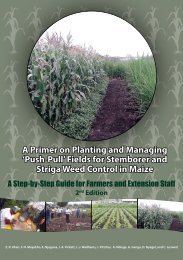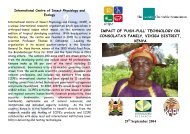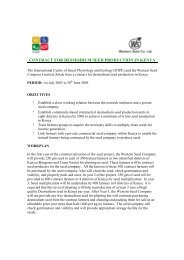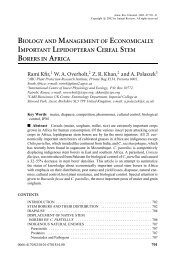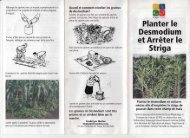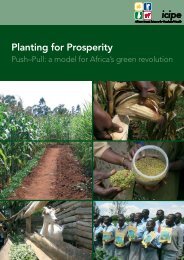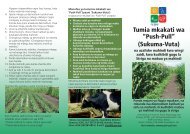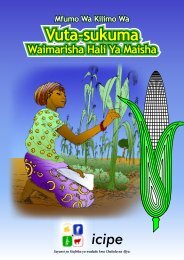The Royal Society Report - Push-Pull
The Royal Society Report - Push-Pull
The Royal Society Report - Push-Pull
You also want an ePaper? Increase the reach of your titles
YUMPU automatically turns print PDFs into web optimized ePapers that Google loves.
3.2.2 Phenotype analysis<br />
Marker-assisted plant breeding places the emphasis on<br />
DNA screening rather than on detailed analysis of the plant<br />
phenotype. However, the breeding cycle is further<br />
enhanced whenever plant phenotypes can be analysed<br />
with higher resolution and greater precision than<br />
previously. In this section we describe various<br />
developments in phenotype analysis that can be combined<br />
with MAS to enhance the identification of crop plants with<br />
agronomically useful genes or combinations of genes.<br />
3.2.2.1 Phenotyping platforms<br />
It is now possible to screen many different plant genotypes<br />
quickly and simultaneously for the traits expressed<br />
(phenotype) using ‘phenotyping platforms’ (Finkel 2009) .<br />
<strong>The</strong>se systems involve the use of precisely defined<br />
environmental conditions and sophisticated imaging and<br />
other recording methods to monitor the growth and<br />
development of crop plants (Xie et al. 2006; Rajendran<br />
et al. 2009). When combined with high-resolution genetic<br />
maps or with mutant collections in which a high proportion<br />
of genes in a genome are disrupted, these platforms are a<br />
very effective way of revealing sets of genes that influence<br />
agronomically significant phenotypes. Trait data can often<br />
be obtained automatically. For instance, root platforms<br />
now allow dynamic characterisation of root system<br />
architecture and sites of root water uptake in hundreds of<br />
plants using non-invasive systems built on computer<br />
tomography (de Dorlodot et al. 2007). Other systems make<br />
it possible to introduce drought stress and measure<br />
biomass, transpiration, leaf growth and architecture, root<br />
growth and architecture and soil water uptake in many<br />
plants in a single experiment.<br />
<strong>The</strong>se phenotyping platforms are sophisticated, resourceintensive<br />
facilities and they are not appropriate for local<br />
breeding institutions. However, they are an essential<br />
component of the research infrastructure in leading<br />
national and international research centres where they are<br />
required for full exploitation of high-resolution genetic<br />
maps and genome sequence data.<br />
3.2.2.2 High throughput analysis of small molecules<br />
Plants make an enormous diversity of small molecules,<br />
which include mediators of communication between<br />
plants, between microbes and between plants and<br />
microbes. High throughput analysis (a technique which<br />
allows the fast analysis of a large number of molecules in<br />
parallel) based on mass spectrometry now allows these<br />
small molecule populations to be better described (Schauer<br />
& Fernie 2006). In some instances functions can be<br />
assigned to these small molecules by combining mass<br />
spectrometry output with expression profiling and<br />
phenotype analysis. <strong>The</strong>se high throughput approaches<br />
have revolutionised our ability to analyze the natural<br />
chemicals in plants and other organisms: it is no longer<br />
necessary to devise separate assay methods for each type<br />
of chemical because in a single sample it is now possible<br />
to identify thousands of compounds.<br />
Application of these methods now allows a chemical profile<br />
of individual plants in the progeny of breeding crosses or<br />
following particular crop management strategies. Individual<br />
compounds or sets of compounds can then be used as<br />
indicators of useful traits in the way that DNA markers are<br />
used as described in Section 3.2.1.1. In large-scale<br />
breeding programmes and trials of new crop management<br />
practice it may be easier and more efficient to assay the<br />
compounds rather than the traits when there are many<br />
plant lines or crop treatments under investigation. In effect<br />
this would be a ‘metabolic marker’ approach that could be<br />
used together with, or instead of, DNA markers.<br />
Recent work illustrates the potential of this approach: a set<br />
of metabolites was identified that is associated with plant<br />
acclimation to cold (Guy et al. 2008). This work was carried<br />
out in the model species Arabidopsis but similar analyses<br />
could be repeated in crops and applied to a variety of traits.<br />
<strong>The</strong>se assays would provide metabolic markers, for<br />
example, of crucial stress-sensitive stages of development<br />
of our major crops, eg grain abortion and early seed<br />
growth under drought or other crucial traits. <strong>The</strong><br />
development of these methods is not as well advanced as<br />
DNA MAS but they are likely to be an important<br />
complementary approach over the next five years.<br />
In the longer term new technologies for chemical<br />
characterisation also link to the development of novel crop<br />
protection chemicals. Many of the existing crop protection<br />
chemicals are based on natural compounds found in<br />
plants. Some herbicides are plant hormone derivatives and<br />
compounds to protect from disease may be based on<br />
chemicals in plants involved in signalling during disease<br />
resistance. With the availability of high throughput<br />
methods to characterise the chemical composition of crop<br />
plants there is a long-term opportunity to identify novel<br />
compounds that can be applied to crop plants sustainably.<br />
3.2.2.3 Isotopic analysis for drought resistance or<br />
high water use efficiency<br />
In 1982 Farquhar and co-workers developed a method for<br />
assessing water use efficiency of crops using the ratio of<br />
the abundance of the natural isotopes of carbon, 13 C and<br />
12<br />
C (Farquhar et al. 1994). During diffusion and biochemical<br />
fixation of CO 2 , the ratio 13 C/ 12 C is different from the<br />
normal abundance in the atmosphere. <strong>The</strong> ratio depends<br />
on the balance between diffusion into the leaf and<br />
demand, so a measure of the ratio gives a measure of<br />
water use efficiency. <strong>The</strong> approach has now been used to<br />
investigate water use efficiency in many crops. In C3<br />
plants, the technique has led directly to the selection of<br />
improved crop varieties, most notably Q15 in wheat<br />
(Condon et al. 2004). However, it is not suitable for<br />
screening C4 plants such as maize.<br />
3.2.2.4 Modelling<br />
Progress in breeding for high and stable yields in crop plants<br />
under many kinds of environmental stress would be greatly<br />
speeded up if it were possible to predict the consequences<br />
24 I October 2009 I Reaping the Benefits <strong>The</strong> <strong>Royal</strong> <strong>Society</strong>



